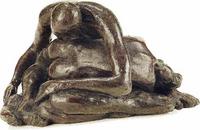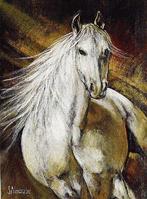
Repose - Contributed
AT The end of America's 'roaring twenties' Susan Alexander was born in New York in that country. In October of that year, the Great Wall Street Crash marked the end of a vibrant period of cultural and technological revolution in the United States. Susan, however, seems to have been infused with the dynamic energy that was the hallmark of the earlier part of that decade.
Although she was born during some tough times for the US, her parents encouraged an apparently early aptitude for painting. They also managed to send her to the best schools to receive formal training in the pursuits that would become a major part of her life. In New York, she studied at Pratt Institute and, after World War II, the all-female Skidmore College. The artist then spent a year at l'école des Beaux-Arts, the same French institution that produced such luminaries as Degas and Monet.
In 1951, Alexander came to this island and stayed. What ensued was nothing short of a love affair, the evidence of which can be seen in Jamaican Journey. The book, which was launched last Sunday at Terra Nova All-Suite hotel, contains what Susan calls "a small sample of my work". In fact, the 105-page tome is a fairly comprehensive look at one of the most significant contributions to the tapestry that is Jamaican art.
Spirituality and sensuality

Merrymaking
Susan's chosen media are oil paint, pastels, bronze and polyform - a synthetic polymer or hard plastic. Her work seems to have been inspired by her loves: horses, dance, Jamaican people and love. As the book's title states, her most influential muse has been Jamaica - its people, its flora, its spirituality and its sensuality.
Stylistically, her work is all about movement. Whether she is painting or sculpting, Alexander sees movement in just about everything. From the staccato placement of limbs and loincloths in 'Arawak Dance', to the fluid motion of bodies and the textured background of 'Eden', each piece keeps the eye moving. One can almost hear music in the sculpted lovers of 'Repose'.
Susan's relationship with Jamaica doesn't end at voyeurism. In 1977, she started an art programme at two of this country's maximum security prisons. For about a decade, she taught and mentored inmates at General Penitentiary and St Catherine District Prison. She also opened Upstairs Downstairs Gallery along with her husband, Neville. The gallery had monthly exhibits which would often include musical and dance performances. In particular, young artists and foreign artists were highlighted.
Danced professionally

Wind Dancer
Alexander danced professionally for a while, travelling to the US and Cuba with Eddy Thomas' Jamaica Dance Company. She has also designed costumes and sets for the National Dance Theatre Company. Little surprise, then, that dance is one of the prevalent themes in her work. Pieces like 'Two Drums for Babylon' and 'The King Must Die' are renditions of dance numbers. In other pieces, the dance happens in her placement of shapes and arrangement of colours.
Jamaican Journey is an illuminating look at the creative output of an inspired artist. It allows readers to fall in love with Susan Alexander's Jamaica through her eyes and her feelings. At the same time, it provides a look at a solid body of work spanning the better part of Jamaican art's modern history.
Kudos to Susan on the production of an important publication that is also a joy to read.